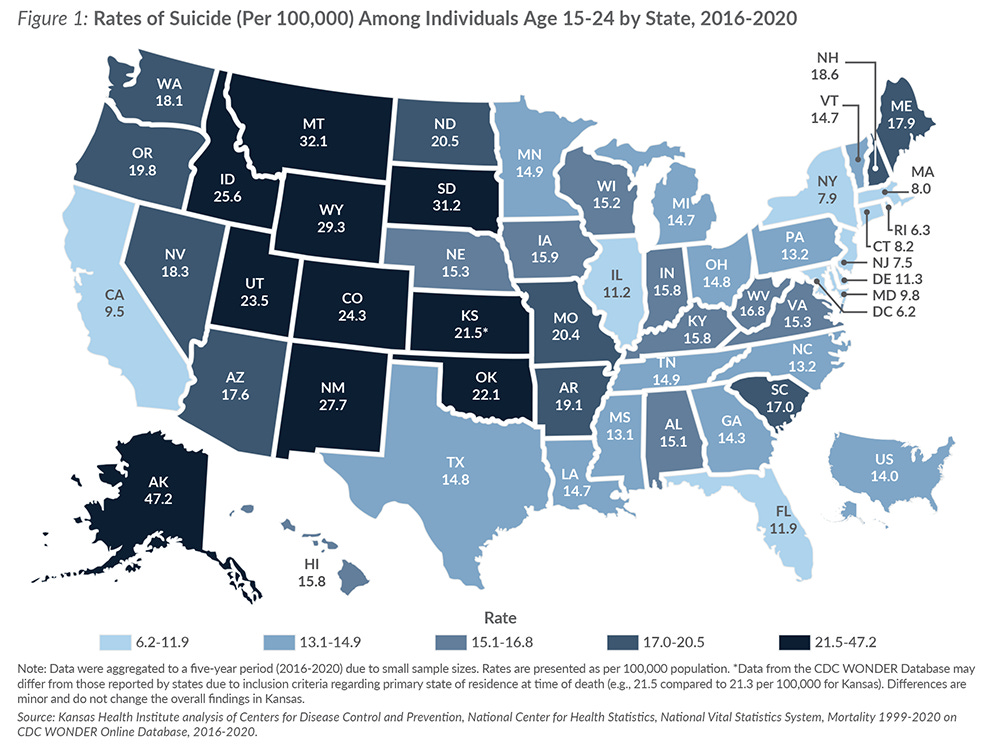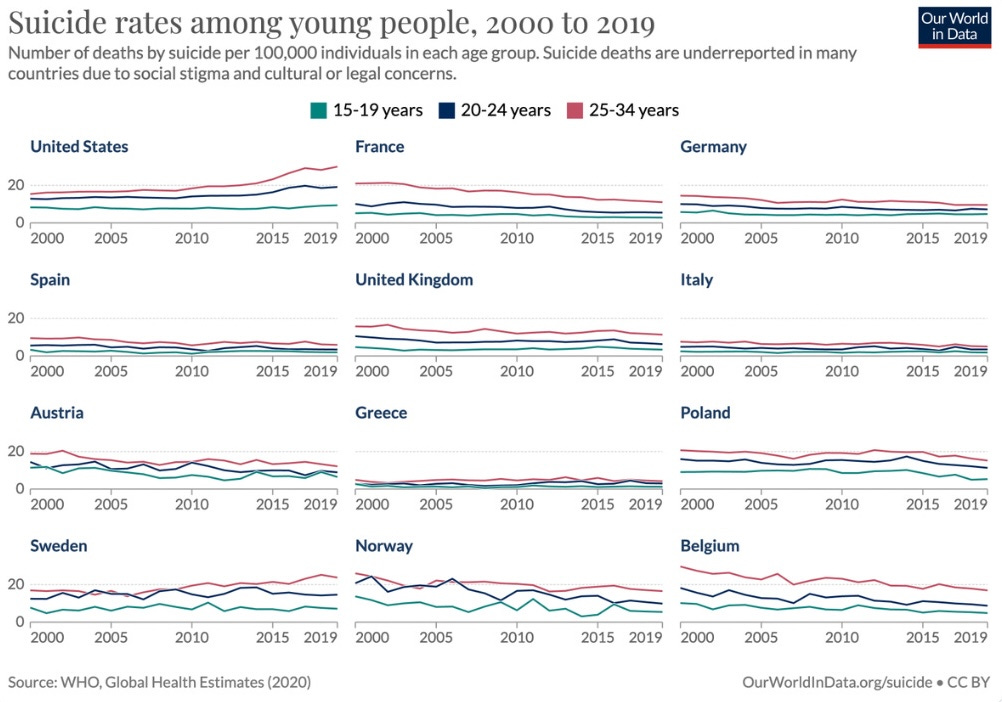Banning Adolescents Off Social Media Won't Fix Their Mental Health
The fixation with social media as the root of rising teen suicides blinds us to critical factors that you rarely hear anyone talking about in conversations about teen mental health.
As a psychiatrist who’s been through their own mental health journey, I care a lot about adolescent mental health. I also despise much of what’s said about it.
It seems like everyone is fixated on just one thing:
Blame social media and smartphones for adolescents’ declining mental health. It’s so bad that it’s now gotten to the point where this made up cause-and-effect relationship is now being taken for granted. Well… fuck that.
Blame Schools Before You Blame Social Media.
Youth suicides vary over the academic year — like… they vary a lot.
Relative to January, youth suicides tend to drop ~30% during the summer and winter holidays. Adolescents use social media more during the holidays, so it really contradicts the narrative painted by most of the media.
If you look at the error bars for the chart on the left (1990-2019), you’ll notice just how consistent the relationship between time off from school and youth suicides has been… both before and after the age of smartphones.
This is reiterated by one of the papers I mention in my most recent YouTube video, which identifies peer competitiveness as a much stronger predictor of adolescent poor mental health — more so than time spent on social media.
While You’re At It, Blame Small Towns In America…
Another thing no one ever talks about? US adolescents living in rural areas are twice as likely to end their own lives as adolescents living in large cities.
In fact, let’s make this a little more uncomfortable…
Many US States (& Politicians) Are Failing Adolescents
I hate to be a conspiracy theorist, but I feel that much of the fixation on social media is being driven by politicians who wish to absolve themselves of that responsibility in front of voters come election time. But no… just look at any map showing youth suicides in the United States, state by state. Interesting, right?
Adolescent social media use is ubiquitous across the United States. Yet, New York and Rhode Island have youth suicide rates that are half that of the national average, while the mountain states and Alaska report 4x those rates. Are adolescents in Alaska spending more time on social media than New Yorkers?
(Answer: No.)
Adolescents Around The World Use Social Media
And most of them are fine.
Suicide rates among young people have continued to drop in many developed countries, despite the increase in social media use. Unfortunately, the rise in teen suicides appears to be a strictly Anglosphere issue, affecting the United States, the United Kingdom, Australia, Canada, and New Zealand.
Concerns Over Screen Time Are Disingenuous
Teens don’t watch TV anymore. In fact, the numbers are staggering.
It seems that social media has replaced TV for a lot of young people, making the concerns about the dangers of screen time appear a little disingenuous.
Most US Teens Feel Social Media Has A Positive Impact
80% say social media helps them feel more connected with friends
71% say social media provides them with a space to show creativity
67% say social media connects them to people who can provide them with the support they need when they’re going through a tough time
58% say what they see on social media makes them feel more accepted
Banning adolescents from social media is not the answer.
Articles like Generation Tech’s Substack piece that go through 13 reasons (one by one) for the adolescent mental health crisis, explaining why none of them can perfectly explain why teen suicides are rising… only to then conclude that the culprit must be smartphones… are both lazy and dangerous.
New Yorker pieces written by journalists who, frankly, have no business writing about science, especially with such obnoxious certitude, alarm and scare me.
I care about adolescent mental health.
If you do too, please don’t reduce adolescent mental health to a conversation about social media. Doing so, only serves to undermine the teens, which (no surprise there) no one really seems to be interested in listening to.
The only people who stand to benefit from this narrative are the bad parents, the lazy teachers, and the self-serving politicians — all of whom wish to wash their hands clean of their responsibility towards young people.
Well… fuck that and fuck all of them.
You can watch my YouTube video where I talk about even more studies, using the link below. The list of references should be just under it.
References
Booker, C. L., Kelly, Y. J., & Sacker, A. (2018). Gender differences in the associations between age trends of social media interaction and well-being among 10-15 year olds in the UK. BMC public health, 18(1), 321. https://doi.org/10.1186/s12889-018-5220-4
Course-Choi, J., & Hammond, L. (2021). Social Media Use and Adolescent Well-Being: A Narrative Review of Longitudinal Studies. Cyberpsychology, behavior and social networking, 24(4), 223–236. https://doi.org/10.1089/cyber.2020.0020
van den Eijnden, R., Koning, I., Doornwaard, S., van Gurp, F., & Ter Bogt, T. (2018). The impact of heavy and disordered use of games and social media on adolescents' psychological, social, and school functioning. Journal of behavioral addictions, 7(3), 697–706. https://doi.org/10.1556/2006.7.2018.65
Ferguson, C. J., Muñoz, M. E., Garza, A., & Galindo, M. (2014). Concurrent and prospective analyses of peer, television and social media influences on body dissatisfaction, eating disorder symptoms and life satisfaction in adolescent girls. Journal of youth and adolescence, 43(1), 1–14. https://doi.org/10.1007/s10964-012-9898-9
Rutter, L. A., Thompson, H. M., Howard, J., Riley, T. N., De Jesús-Romero, R., & Lorenzo-Luaces, L. (2021). Social Media Use, Physical Activity, and Internalizing Symptoms in Adolescence: Cross-sectional Analysis. JMIR mental health, 8(9), e26134. https://doi.org/10.2196/26134
Tiggemann, M., & Slater, A. (2017). Facebook and body image concern in adolescent girls: A prospective study. The International journal of eating disorders, 50(1), 80–83. https://doi.org/10.1002/eat.22640











Interesting take, I do agree that just banning social media to teenagers is a lazy approach.
Suicide is a complex phenomenon for which science can inform but will likely be far from a panacea. If you take positivist sociology from the XIX century seriously Protestants will always have a higher likelihood of killing themselves than Catholics.
It's hard for any study to determine how social media is used, giving the layers of irony baked into certain content, especially in racist and self-harming circles. So yeah, you mount a good case to remain skeptical given the poor evidence and assumptions of blanket statements like those of the New Yorker article.
Yet, what is concerning to me isn't so much the linear relationship between social media usage and teen suicide, but how this tech alters how we think and socialize.
It's broadly clear that online discussion isn't about clearing the fog of ignorance as much as it is about amplifying the depth of already held assumptions, as Godwin’s law or this very comment section already indicates.
This tendency, paired with the drive of companies to increase the engagement and attention spent in their platform with algorithmic tools -that try to get you what you want, or make you want - may lead to echo chambers that reinforce a pathological relationship with social media.
Without being reductionist or implying that going back to a golden era will solve our problems, it becomes necessary to try to hold the diverse contradictions social media creates: where kids today connect in a completely different way to previous generations, which sometimes will turn into extraordinary positive art and collective action, and others, may just make them drown in the cesspool of hate and self-damage. This may just be happening right now by using the very same platform.
I have been following the debate between Jon Haidt and his critics. IMO both stories are valid. We don't have evidence of causality yet but both social factors and social media seem like valid confounding factors.